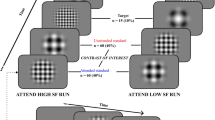Abstract
The influence of exercise intensity on information processing in the central nervous system was investigated using P300 and no-go P300 event-related potentials. Twelve subjects (22–33 years) performed a go/no-go reaction time task in a control condition, and again after high-, medium-, and low-intensity pedaling exercises. Compared to the control condition, P300 amplitude decreased after high-intensity pedaling exercise and increased after medium-intensity pedaling exercise. There was no change after low-intensity pedaling exercise. These results suggested that the amount of attentional resources devoted to a given task decreased after high-intensity exercise and increased after medium-intensity exercise. The findings also suggest that changes in P300 amplitude are an inverted U-shaped behavior of differences in exercise intensity. In addition, no-go P300 amplitude showed the same changes as P300 amplitude at different exercise intensities. This indicates that differences in exercise intensity influenced not only the intensity of processing the requirement for a go response, but also processing of the need for a no-go response. It is concluded that differences in exercise intensity influenced information processing in the CNS.



Similar content being viewed by others
References
Bokura H, Yamaguchi S, Kobayashi S (2001) Electrophysiological correlates for response inhibition in a Go/NoGo task. Clin Neurophysiol 112:2224–2232
Borg G (1970) Perceived exertion as an indicator of somatic stress. Scand J Rehabil Med 2:92–98
Bruin KJ, Wijers AA, van Staveren ASJ (2001) Response priming in a go/nogo task: do we have to explain the go/nogo N2 effect in terms of response activation instead of inhibition? Clin Neurophysiol 112:1660–1671
Donchin E, Coles MGH (1988) Is the P300 component a manifestation of context updating? Behav Brain Sci 11:357–427
Doucet C, Stelmack RM (1999) The effect of response execution on P3 latency, reaction time, and movement time. Psychophysiology 36:351–363
Falkenstein M, Hoormannn J, Hohnsbein J (1999) ERP components in Go/Nogo tasks and their relation to inhibition. Acta Psychol (Amst) 101:267–291
Fallgatter AJ, Strik WK (1999) The Nogo-anteriorization as a neurophysiological standard-index for cognitive response control. Int J Psychophysiol 32:233–238
Fery YA, Ferry A, Vom Hofe A, Rieu M (1997) Effect of physical exhaustion on cognitive functioning. Percept Mot Skills 84:291–298
Kaseda Y, Jiang C, Kurosawa K, Minori Y, Nakamura S (1998) Objective evaluation of fatigue by event-related potentials. J Neurol Sci 158:96–100
Kok A (1990) Internal and external control: a two-factor model of amplitude change of event-related potentials. Acta Psychol (Amst) 74:203–236
Kok A (2001) On the utility of P3 amplitude as a measure of processing capacity. Psychophysiology 38:557–577
Kramer A, Spinks J (1991) Capacity views of human information processing. In: Jennings JR, Coles MGH (eds) Handbook of cognitive psychophysiology: central and automatic nervous system approaches. Wiley, Chichester, England, pp 179–249
Kramer AF, Strayer DL (1988) Assessing the development of automatic processing: an application of dual-task and event-related brain potential methodologies. Biol Psychol 26:231–367
Kutas M, McCarthy G, Donchin E (1977) Augumenting mental chronometry: the P3 as a measure of stimulus evaluation time. Science 197:792–795
Magnie MN, Berman S, Martin F, Madany-Lounis M, Suisse G, Muhammad W, Dolisi C (2000) P300, N400, aerobic fitness, and maximal aerobic exercise. Psychophysiology 37:369–377
McCarthy G, Donchin E (1981) A metric for thought: a comparison of P300 latency and reaction time. Science 211:77–80
Nakamura Y, Nishimoto K, Akamatu M, Takahashi M, Maruyama A (1999) The effect of jogging on P300 event related potentials. Electromyogr Clin Neurophysiol 39:71–74
Nishihira Y, Ohno T, Hatta A, Fumoto M, Kaneda T, Tokitou S, Imanaka K, Funase K (1999) P300 before and after transient hard exercise. Adv Exerc Sports Physiol 5:49–54
Norman DA, Shallice T (1986) Attention to action: Willed and automatic control of behaviour. In: Davidson RJ, Schwartz GE, Shapiro D (eds) Consciousness and self-regulation. Plenum, New York, pp 1–18
Pfefferbaum A, Ford J, Johnson R, Wenegrant B, Kopell BS (1983) Manipulation of P3 latency: speed vs. accuracy instructions. Electroencephalogr Clin Neurophysiol 55:188–197
Polich J (1986) Attention, probability, and task demands as determinants of P300 latency from auditory stimuli. Electroencephalogr Clin Neurophysiol 63:251–259
Polich J (1987) Task difficulty, probability, and inter-stimulus interval as determinants of P300 from auditory stimuli. Electroencephalogr Clin Neurophysiol 68:311–320
Polich J, Kok A (1995) Cognitive and biological determinants of P300: an integrative review. Biol Psychol 41:103–146
Polich J, Lardon MT (1997) P300 and long-term physical exercise. Electroencephalogr Clin Neurophysiol 103:493–498
Ragot R (1984) Perceptual and motor space representation: an event related potential study. Psychophysiology 21:159–170
Ragot R, Lesevre N (1986) Electrophysiological study of intrahemispheric S-R compatibility effects elicited by visual directional cues. Psychophysiology 23:19–27
Schubert M, Johannes S, Koch M, Wieringa BM, Dengler R, Munte TF (1998) Differential effects of two motor tasks on ERPs in an auditory classification task: evidence of shared cognitive resources. Neurosci Res 30:125–134
Squires KC, Squires NK, Hillyard SA (1975) Decision-related cortical potentials during an auditory signal detection task with cued observation intervals. J Exp Psychol Hum Percept Perform 1:268–279
Tomporowski PD, Ellis NR (1986) Effects of exercise on cognitive processes: A review. Psychol Bull 99:338–346
Wickens C, Kramer A, Vanasse L, Donchin E (1983) Performance of concurrent tasks: a psychophysiological analysis of the reciprocity of information processing resources. Science 221:1080–1082
Yagi Y, Coburn KL, Estes KM, Arruda JE (1999) Effects of aerobic exercise and gender on visual and auditory P300, reaction time, and accuracy. Eur J Appl Physiol 80:402–408
Yerkes RM, Dodson JD (1908) The relation of strength of stimulus to rapidity of habit-formation. J Comp Neurol Psychol 18:459–482
Acknowledgement
This study was supported by the Nishihira/Tsukuba Project of Center of Excellence from the Japan Ministry of Education, Culture, Sports, Science, and Technology.
Author information
Authors and Affiliations
Corresponding author
Rights and permissions
About this article
Cite this article
Kamijo, K., Nishihira, Y., Hatta, A. et al. Differential influences of exercise intensity on information processing in the central nervous system. Eur J Appl Physiol 92, 305–311 (2004). https://doi.org/10.1007/s00421-004-1097-2
Accepted:
Published:
Issue Date:
DOI: https://doi.org/10.1007/s00421-004-1097-2




